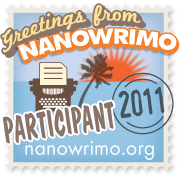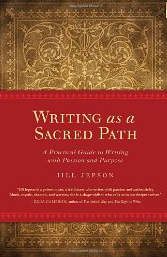 This year, my participation in National Novel Writing Month (NaNoWriMo) was on-again, off-again. Still, in addition to my other writing, I wrote 18,001 words, finishing the rough draft of one screenplay and delving into a children’s novel. I’m very pleased with the results, although some year I’d like to be an official NaNoWriMo winner (which means writing an entire novel of at least 50,000 words during November). I especially enjoy the communal aspect of NaNo writing–a number of writers I know participate in NaNoWriMo and we support each other through the online forums and even local get-togethers, though this year I didn’t make it to any local write-ins. But I reconnected with and met some cool writers online, and I’m looking forward to continuing to support each other in our writing goals over the coming year.
This year, my participation in National Novel Writing Month (NaNoWriMo) was on-again, off-again. Still, in addition to my other writing, I wrote 18,001 words, finishing the rough draft of one screenplay and delving into a children’s novel. I’m very pleased with the results, although some year I’d like to be an official NaNoWriMo winner (which means writing an entire novel of at least 50,000 words during November). I especially enjoy the communal aspect of NaNo writing–a number of writers I know participate in NaNoWriMo and we support each other through the online forums and even local get-togethers, though this year I didn’t make it to any local write-ins. But I reconnected with and met some cool writers online, and I’m looking forward to continuing to support each other in our writing goals over the coming year.
This year, one of the pep talks was posted by one of my favorite fantasy writers, Brandon Sanderson. (Brandon also does a really cool writing podcast called Writing Excuses with several other writers that I find helpful and enjoyable.) I appreciated hearing his perspective on using NaNoWriMo as the writing tool it is for us to move forward in our writing. If you’ve ever thought of doing NaNoWriMo, or are interested in developing your writer’s toolbox, his article and approach are well worth the read.
What did I learn from NaNoWriMo this year? I learned more about juggling other events and responsibilities with intensive writing, being more flexible about when I take writing time. For me, a consistent writing schedule is a really helpful practice for me. But sometimes that’s not possible. So this month, I tried to just sneak in a few minutes of writing on days that I really didn’t have a solid block of time. And that was very helpful, so that when I did get back to my writing project after being away for a few days, I was still “connected” and could get back into the writing more quickly.
This month, I’ll let the writing I did during NaNoWriMo rest so that I can edit it with fresh eyes in the new year. Starting today, I’m getting back to writing my next book on the Eucharist.



